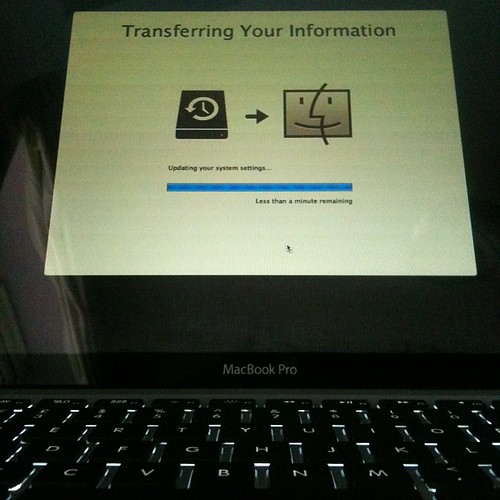After nearly 4 years of faithful service my first Macbook Pro seemed to be getting very slow and very full. It was the machine that I bought on Day 1 of Feeding Edge and it has been to some very interesting places. Not least it sports the Cool Stuff Collective logo as we had to cover up the Apple logo for the TV show.
I have replaced it was another 15″ MBP but not the retina display. They are lovely but it seemed a lot more money for a screen. I ended up with the 2.6Ghz Quad Core, 8Mb RAM and a 720gb Hard drive, plus the dual gfx cards of the intel 4000 and for real performance the nvidia GT 650M 1GB.
It is the first time I have swapped a machine and then migrated. All the previous machines back in the corporate world the transferring of applications was a tiresome job usually involving reinstalling things on windows.

I had a Carbon Copy clone ready just in case but I used my incremental backup with the very useful TimeMachine and set up the new machine to be pretty much like the old machine 🙂 This continuity feels like a refurbishment of a much cherished machine rather than a replacement. It’s like the old machine has found new life from somewhere.
There have been the odd thing that needs its licence renewing or signing in again but its been a very simple, very user friendly experience so far.
Next is to flatten the old machines OS and data and make it a vanilla Macbook Pro again so that the predlets can have their own machine too. That looks nice and straight forward as a recovery option just Cmd R on startup.
I really was dreading moving machines, I held off for a year at least because I couldn’t face the hassle. Now I know it is easy and it just works, like most Apple things, then who knows this may get to be a bit more regular. I do try and get kit at the top end so that it does not make itself too obsolete too soon. Mac’s are expensive compared to a windows laptop but for years windows and the machines around it have given me nothing but trouble. The past 4 years has been almost perfect and seamless in the way I get to just do what I need to do.
Well done Apple. 🙂 Hello old friend in a new body.
Uncategorized
Generating music from an emotion curve
I just came across this interesting looking web application called MusicFlow. I am always fascinated by things that make the creative process more open to anyone. Clearly fully fledged composer and musician is better than a generated algorithm but…. Here you draw a graph on a time line of the sort of rise and fall of emotion you need and it creates a piece of music for that.
There are several video demos, but before I watched these I just had a quick go and straight away had an interesting piece going.
We have some similar things now in iMovie where it generates a score based on the pace of the film, the cuts etc, but it is good to see a more generic one hit the web.
I was also reminded of the old Instant Music program on the Amiga again, as that was the first one I saw that was able to allow an in tune jamming using the mouse which is similar in many ways to drawing an emotion curve. Anyone else remember that?
Let me in – Bitnami, Keychain and SSH on Mac
I have ended up looking at a couple of bitnami created servers both running on Amazon EC2 (Part of amazons cloud service). Bitnami create open source bundles, preconfigured and ready to run in various operating system flavours and with common applications like Drupal and wordpress. With services like Amazon EC2 the cloud service is able to bring up a virtual server for you based on a pre bundled configuration and you are ready to run on seconds. Both these servers required a little bit of extra to and fro to get access to the file system and use the various tools I have for things like Databases. They rely not on user name and passwords but on ownership of a key file called a pem. In a time when most people are getting used to rich user interfaces, touch displays, gesture control etc there is still a time when you have to drop to a much more archaic, but much loved by techies, command line. Yes you type commands in, whatever next? 😉 These can be hard to remember and also tricky if you miss out implicit little pieces of knowledge that you only retain by constantly performing the tasks.
This level of security is important for servers of course, but it does make life awkward when you are have not been tapping away long incantations of linux commands for a while.

To connect to one of these servers I had to first of all get the pem file (the key) on my Mac. However then in order to use it you need to startup the terminal. In order to connect to a server you have to first of all use the terminal and type something along the lines of
ssh -i whateverthekeyis.pem ausername@aservername.amazonaws.com
That opens up another terminal command line but this time a secure encrypted one to the actual machine where the -i indicates which key file you are using. Oh, but it is of course not that simple, no the file permissions have to be tightened up, again with a command line. Chmod changes the read/write access to the file so that only certain users on your machine, i.e. you can use the key at all.
chmod 600 file.pem
This is great if you are just doing command line but if you want another useful Mac application to be able to connect, something like Expandrive (which just makes the file system look like it is part of the mac) then you have to do some other incantations.
My initial thought was that sure the keychain application on the Mac is the place that it will keep all these keys for all the higher end applications to use. When you have something like expandrive and it is expecting to type a user name and password into it to connect you can’t easily tell it to use this PEM file instead. The same goes for Sequel Pro. So I tried to import the PEM file into the keychain, something it does automatically if you double click the PEM. it failed though.
A quick bit of googling later and it turns out that these ones have to be done manually with an
ssh-add -K whatever.pem
That pops the key in a mini cache that anything that is doing SSH under the covers will look at for a userid. Dead simple, once you know or expect to do it. As with all these things it is the not knowing what to ask, or why you would even bother asking that gets in the way.
Once added it meant that I could simply access the file system in a normal finder tree. Whilst I could tap away linux commands in the command line it is very much quicker and easier to have a visual clue as to where things are as you bounce form server to server. As much as a like typing file transfer commands and lots of paths and dots and dashes (It reminds me of the techie I am) I also just want to get on with things.
The same goes for the database. On bitnami the mysql database was accessible with the web tool PHPadmin, but… in order to access the web front end, again for secure reasons you had to create a tunnel on the command line. Again on the command line you had to try something along the lines of
sh -N -L 8888:127.0.0.1:80 -i bitnami_hosting.pem bitnami@xyz.bitnamiapp.com
This is telling the Mac to map and route certain network requests through a secure connection. It will last as long as the terminal window is active. So the command will just hang there. The net result is you can then use a web browser to talk to you own machine, but the tunnel passes you onto the remote machine
So using 127.0.0.1 mean this machine, and port 8888 means a different communication channel really, so the web browser thinks what it is using is on a web server running locally when in fact it is off in the cloud.
This seemed a bit of a pain when I had a great tool like Sequel Pro. This lets me access multiple tables and pieces of data and structure in a similar but less clunky way to phpadmin. Luckily with the key added (as above) you the pem key will automatically be used. However it did not work first time. I had to go into the file system and edit the MYSQL config file my.cnf that was in MYSQL directory to comment out the local binding to that machine.
bind-address = 127.0.0.1 becomes#bind-address = 127.0.0.1
I found/was reminded of that in the bitnami documents (which are great when you know what you are looking for) but I initially comment it out with a // not a # as thats what lots of code is. Yes I know it’s obvious as its a Mysql config file, except its not when a little detail like the comment character to use is missed out. This then let the Mysql client on my Mac connect to the database using the secure key doing all the tunnelling etc itself. So once set up things are quite straight forward and identical to the way I access the same things on my local development server.
All techies have different preferences and ways to get to things. If you are a constant sys admin the command line, and all the variants of clever piping of commands work. I used to tend to do that too. When you are an occasional user across multiple different flavours of system (I have slicehosts/rackspace servers too) then it gets difficult to remember it all.
In addition when you are also building and maintaining the applications on top of that, remembering how to configure and administer Drupal for instance, what your application is doing, how the git repository is accessed etc, or providing extra code and modules that drive those applications. Mixing that up with richer front ends like unity3d and running open source virtual worlds like Opensim the number of “all you have to do is this simple x,y or z” balloons.
It is one reason that in large companies there is a separation of systems admin, database admin, architecture, software development, testing, runtime production, design, research and development and project management. However as a small company it is important to be able to do a little bit of all of that in order to major on any one of those for a project.
So whilst I really don’t like sysadmin, mainly because things are never quite the same in each place, especially in opensource land, I do find I have to do this to remind me of the complexity of the tech we have to deal with and how great it is that so many things can hide this away from us when we really don’t need to know.
I wrote this all down here a I know I will bump into this again and will have forgotten, so in making notes for future confused self I thought it may help anyone else who is stuck and googling for similar things. Of course the hardcore techies will probably laugh at my apparent lack of knowledge (which was less lacking and more filed away and need to be recalled from HSM. Something we had in the olden days when I started on green screen terminals. You would ask for a file and you would have to wait for a mechanical arm somewhere to find the right disk/tape and spin it up, a sort of mechanical cloud) Anyone else who feels worried about doing any deeper techie stuff may also be put off. However those who wander the technical plains finding adventure may just benefit.
Kinect robots from microsoft
I was researching some robot options for The Cool Stuff Collective and I bumped into the Microsoft Robotics at home (US based) competition. It would appear there is now a MS Robotics software dev kit (Developer Studio 4). However the really interesting part is that there is a reference design for some hardware that is based around using the kinect for the machine sensing and vision.
Parallax appear to be taking orders for a piece of kit called Eddie

It comes assembled or in kit form and I have to say this looks really interesting.
I have not found any UK references to this yet. So it looks like I will need a windows 7 laptop as well now then!
Is that me hiding? I don’t think so! more Google Minus
I feel sorry for anyone with an unusual “given” name, one of the Beckhams, Geldoffs or other rock stars. They just wont be able to hang out on google+ because their “name” doesn’t fit the “pattern”.
So after thinking I was ok as Ian/epredator Hughes on google+ turns out I am not.
I, like William Shatner, got suspended for an apparent name violation or some bad pattern match on their processes. Is it hard to tell this is really me? I mean really? Identity is not binary and is not purely based on a string of ascii characters!

I have filled in the form with just a few URL’s proving that I am known as Ian, Mr Hughes, Mr I Hughes, epredator, epred, oi you, sir, son, daddy, boss etc but we shall see.
Its really a big fat google minus – the muppets
Reaching into music with Melodyne
A few years ago I remember we saw a demo of an upcoming product that let you dive directly into the individual notes of an already produced piece of music. i.e. you went from the produced target not the original source. Roo posted it at the time
It was great to bump into the website for the Melodyne editor at Celemony whilst doing some other research.
The really cool thing is they have a full demo for Mac and Windows that lets you play with 9 seconds of any tune you care to throw at it.
I used one of the loops from Garage Band, but only a little bit on this video just to show how simple it is to edit.
The first play is the original but then I move one note up. Note that in this particular view there are other notes playing too as it is part of a chord. So from a Wav file even I can change the individual notes of a track !
So this is me simply importing a wav (in seconds), and dragging a note. Done!
They have lots of flavours of the application but the Editor demoed here is only actually £300 ! The demo download link is on the product web page
Even with the 9 seconds to play with you can feel the amazing power of this. Now if I could just find my own musical talent…
Lego AR in the wild
It was fitting that the last day of the holiday wandering around Disney Downtown we ended up in the Lego Innovations store. For some reason I nearly missed seeing the Augmented Reality kiosk that lets you see whats inside your lego box.

I have seen this in videos before, but it was good to have a go with what is an ar Magic Mirror in a commercial environment.
Certain lego boxes are available near the kiosk and you just hold it up and away it goes. It animates the contents of the box.
There were a few peoples who did not notice it either, once I started using it a queue formed 🙂 Dad’s were busy video it and kids were busy going wow look at that.
Maybe these bodes well for the next gen tech they will start using in the theme parks as we saw lots of 3d (with glasses) of course and a location based service using a mobile for a treasure hunt.
Epcot did have this

An energy sweeping game. It used what looked like a metal detector or round shuffle board stick to move virtual energy “pucks” that had to be croupier pushed to various stations. It was by Siemens, and was OK but a bit laggy.
New nerdcore anthem- New Dorks
This is great, and props to @GemmaCocker for tweeting and blogging it 🙂
New Dork – Genius 🙂
Hmmm Upgrades. Second Life Viewer 2 appearing
A video is already up on youtube of Second Life Viewer 2
The next few days as we all get to download and use it we will see how the changes and improvements affect us all. It should be good, as its been a long time coming. Lets see though.
Performance bell curves don’t work!
Towards the end of each year and start of the next many people in “serious businesses'” seem to have to suffer the torture that is the annual performance review. Not having to deal with this ridiculous set of processes this year has not kept me away from it. I still see the unfortunate side effects that the various systems used have on people, their morale and their sense of belonging to an organization.
What tends to happen in most large companies is that they have decided that everyone should be measured against some set of targets. (That sort of makes sense). They then decide that clearly some people will be better at things that others. (Another correct assumption). They then decide that a bell curve should be applied to the performance of people. i.e. lots in the middle of the road and some great people at one end and no so great at the other. (This also makes some sense).
Then the logic goes out of the window in favour of process.
The bell curve is not applies across the entire population at once. Instead it is broken up into bell curve copies with equal weighting and applied to nominal collections of individuals, such as a department. As each department and individuals actual objectives are probably different the relative performance and the bell curve are in effect blown to pieces, like for like is not easily applied.
Various groups of individuals may have champions in the political systems who fight for a greater share of the bell curve, but many will instead try and fit the bell curve onto their people then attempt to justify their decisions.
A whole heap of time and money is wasted in many large corporations in order to ensure that the status quo is maintained.
I have experience all ends of the spectrum in these evaluations. If you get an outstanding result you feel great, but also slightly guilty. Very few people will take people to the pub to celebrate their “outstanding” performance rating.
Those that get the next level down (typically there are only 4 or 5 ratings) feel sort of happy, but annoyed at being so close yet so far form being told they are great.
The next rating is really “yep you are just about doing you job” thanks very much for that!
The other ratings are typically supposed to be a wake up call of some sort, or a threat, or “well its just your turn”. The slightest reason can be used to reduce someone to a low performer. I have heard and experienced enough aberrations in the process such as the particular dichotomy of receiving some of these ratings dressed up as business but knowing they were personal and possibly bullying, to know that the systems used are damaging in so many ways.
So what does a company achieve by attempting to centralise and control the distribution of performance?
Well they force most people to be mediocre, and hence the company to be mediocre.
Once thing social media has taught us is that even the most mediocre employee in a company can have a huge impact on the direction of the business. So surely it is time for the HR departments to find some innovation somewhere?
This is not to hide from competition and merit, but to actually put that back onto a footing where it means something.
I have to consider these things even more deeply in how the companies I am helping create, that I work with and possibly for deal with people.
